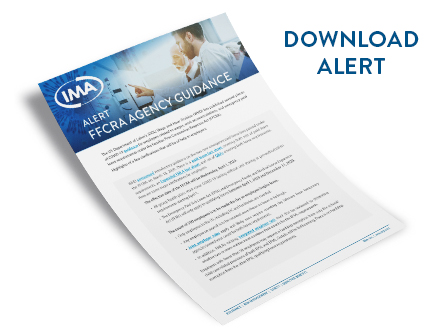COVID-19
FFCRA Agency Guidance
Guidance when dealing with coronavirus
Coronavirus has had an impact on the ability of businesses to perform obligations.
FFCRA Agency Guidance
The US Department of Labor’s (DOL) Wage and Hour Division (WHD) has published several pieces of COVID-19 guidance for employers related to wages, work accommodations, and emergency paid leave requirements under the Families First Coronavirus Response Act (FFCRA).
Below we’ll highlight a few clarifications that will be of help to employers.
WHD announced introductory guidance on the two new emergency paid leave laws passed under the FFCRA on March 18, 2020. There is a paid leave fact sheet covering both sets of paid leave requirements, an Expanded FMLA fact sheet, and set of Q&As covering both leave requirements.
Here are some major clarifications for employers:
The effective date of the FFCRA will be Wednesday, April 1, 2020.
- All group health plans must cover COVID-19 testing without cost sharing or pre-authorization requirements starting April 1.
- The Emergency Paid Sick Leave Act (EPSL) and Emergency Family and Medical Leave Expansion Act (EFML) will only apply to qualifying leaves between April 1, 2020 and December 31, 2020.
The count of 500 employees is to be made the day an employee begins leave.
- Only employees in the US, including DC and territories, are counted.
- Any employee on payroll is to be counted, even those on leave or furlough.
- Joint employer rules apply and likely even require counting day laborers from temporary agencies toward your count for both leave requirements.
- In addition, FMLA’s existing integrated employer test must also be reviewed to determine whether two or more entities must combine their counts for the EFML requirements.
Employers with fewer than 50 employees may request a hardship exemption from only the school/child care related provisions of both EPSL and EFML. Details will be forthcoming. There is no hardship exemption from the other EPSL qualifying leave requirements.
- For part-time employees, EPSL should be paid based on the number of hours worked in the employee’s average two-week schedule. If the employee doesn’t have a regular schedule, an average of the prior 6 months of work is used.
- Overtime must be accommodated by EPSL if that’s a normal part of the employee’s schedule.
- For example, if a full-time employee normally works 50 hours per week, they would take 50 hours the first week and the remaining 30 hours of EPSL the second week (because EPSL is capped at 80 hours for the year per full-time employee).
- Hours over 40 in a week for non-exempt workers are subject to 1.5 times pay.
- The employee’s regular rate of pay is the average rate of pay over up to 6 months prior to taking leave. Commissions, tips, and piece rates all count.
- EFML is for employees who have been on payroll for at least 30 days immediately prior to the leave beginning (regardless of hours during those 30 days).
- So when EFML takes effect April 1, 2020, any employee employed (on the employer’s payroll, regardless of hours) from March 2, 2020, through March 31, 2020, will be covered.
- If the employer hires a temp, time served for that employer as a temp will count.
- A model notice/poster is now available.
Fair Labor Standards Act (FLSA) FAQs clarify numerous wage, accommodation, and work-from-home questions for employers, including the following:
While a private employer may require exempt, salaried employees take accrued paid leave time for full or partial office closure days, they must receive their full week salary for any week in which they perform any work. So if they don’t have accrued leave to utilize, they must nevertheless be paid in full for a week in which they performed any work.
The FLSA does permit employers to require employees to perform job duties outside their usual job description. Only employees under age 18 have restrictions on allowable job duties.
An employer may encourage or require telework during a pandemic or as a reasonable accommodation, so long as such requests/requirements are not discriminatory.
- The employer must pay the regular salary for exempt, salaried employees for any week they perform any work, and must pay the regular rate of pay when accommodating a disability.
- Otherwise, outside of other contractual obligations, the employer just needs to ensure hours are properly tracked and employees are paid at least the minimum wage for hours actually worked (and 1.5 times the employee’s pay rate when working over 40 hours in a week for non-exempt workers).
While employers are not liable for an employee’s home working conditions, the employer will remain responsible to keep records of work-related injuries/illnesses occurring in a home office.
Final joint employer rules issued in January became effective March 16, 2020, and may impact FLSA requirements on employers utilizing temporary workers from staffing companies.
More guidance will be forthcoming from the regulatory agencies in the coming days.
This material is for general information only and should not be considered as a substitute for legal, medical, tax and/or actuarial advice. Contact the appropriate professional counsel for such matters. These materials are not exhaustive and are subject to possible changes in applicable laws, rules, and regulations and their interpretations.
